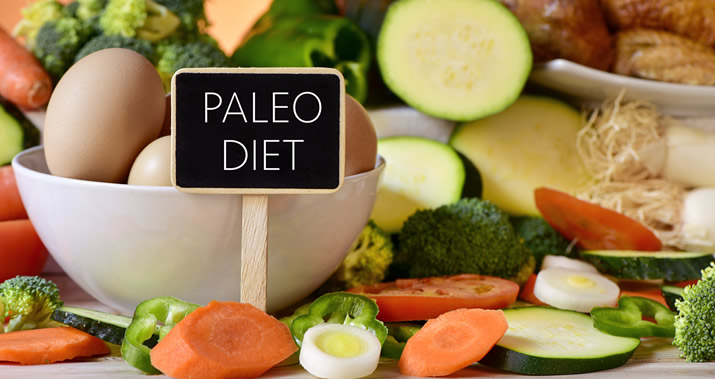
For the past few years, there has been a lot of hype around the Paleo Diet, also known as the Caveman Diet. First described in 1975 by medical researcher Walter L. Voegtlin, the food plan mimics the diet of our ancestors who lived during the Paleolithic period. It is based on the principle that, to achieve optimal well-being, you must go back to how the hunters and gatherers ate over 2.5 million years ago.
Processed foods did not exist during this time. The cavemen ate the things they found around them – meat, vegetables, fruits and nuts, and, unlike most modern people, did not eat refined sugar, refined salt, alcohol, grains, beans, legumes, or dairy products.
Fans of this diet claim that the human body is designed to eat like the hunters and gatherers and that grains, dairy, sugars, alcohol and processed foods have led to obesity, allergies and other health problems. They also believe that eating the Paleo diet can lead to weight loss and overall general wellness.
Most Americans eat a much narrower selection of fruits, vegetables, and nuts, and in lesser quantities than our cavemen ancestors. Here is something to consider- the top six calorie sources in the diet of Americans today are: grain-based desserts (cake, cookies, pies, etc.), yeast breads, chicken-based dishes, sweetened beverages, pizza, and alcoholic drinks. These are not the foods of our ancestors, nor are they foods that any nutrition expert would ever recommend. So when proponents of the Paleo diet claim that our modern Western diet is unhealthy, they are correct.
How Does a Paleo Diet Work?
Your body’s preferred source of energy is fats. Fat is a slow burning fuel. However, due to the amount of carbohydrates that we consume on a daily basis in the western world, our bodies burn carbohydrates rather than fat. So, when we take in more carbohydrates than are needed for energy, our bodies store the rest as fat for a later time, when it may be needed. This process is a mechanism that our bodies adapted when we needed to store fat in case we couldn’t find food for weeks.
Today, for the most part, people are rarely in danger of not eating for extended periods of time. We almost never have to resort to using our fat stores for energy. So, instead of eventually burning the fat we are storing in our bodies, we simply add to it, time and time again. This leads to obesity.
The Paleo diet changes this by removing a lot of the simple carbohydrates from your diet. When this happens, your body can no longer rely on carbohydrates for energy, so it is forced to use its fat stores. Without the constant influx of cheap carbohydrates that it would normally turn into sugar, your body’s blood sugar drops to a normal level and your insulin levels begin to regulate. When your insulin levels are regulated, your body is able to release the triglycerides (fat stores) that it has been holding onto and convert them into energy.
Foods Within a Paleo Diet
The Paleo Diet focuses on foods that are ‘close to the earth’. These foods (fresh fruits, vegetables, meats, and seafood) are high in soluble fiber, antioxidants, Omega-3 and monounsaturated fats, and low-glycemic carbohydrates, all of which promote good health. The diet limits the foods and nutrients (refined sugars and grains, trans-fats, salt, high-glycemic carbohydrates, and processed foods) that frequently may cause weight gain, cardiovascular disease, diabetes, and numerous other health problems.
The Paleo Diet encourages dieters to replace dairy and grain products with fresh fruits and vegetables – foods that are more nutritious than whole grains or dairy products. The following is a list of foods included in the Paleo diet:
- Lean Meats and Poultry – beef, veal, venison, lamb, chicken, bison, etc. (try to eat the grass-fed versions of these if at all possible)
- Fish- salmon, tuna, tilapia, bass
- Eggs
- Vegetables
- Oils – Olive oil, coconut oil, avocado oil
- Fruits
- Nuts
- Tubers – Sweet potatoes and yams
*Legumes are NOT Paleo. A legume is a pod fruit. Legumes include: beans, peas, lentils, peanuts, alfalfa, clover, carob, and soy.
The Pros and Cons of a Paleo Diet
Early research has shown that the Paleo diet may reduce cholesterol and blood sugar levels. There is no denying that limiting your consumption of processed foods and sugars is healthy. In addition, the Paleo diet is low in sodium. Eating a low sodium diet can help keep blood pressure levels down.
The Paleo diet forces you to eat a cleaner diet, free from chemicals, preservatives or additives. Also, the higher intake of protein may have you feeling full longer.
Despite its supposed benefits, some claim that the diet is unrealistic. It is restrictive and expensive, and it requires a lot of planning and preparation. It can be difficult to maintain a diet that restricts all processed foods, and almost impossible to eat out at a restaurant while adhering to the plan. In order to travel and eat out on this diet, you would have to bring your meals with you.
The Paleo diet excludes grains, beans and legumes, all of which are rich in nutrients and fiber. While it is possible to get your daily nutrients from the Paleo diet, it is harder to do so than it is on a less restrictive diet. Those people who used to a high-carbohydrate diet may also find the transition to a Paleo diet difficult, as the scarcity of glucose may cause hormonal changes that can impact your blood lipid levels.
No diet plan is perfect. The Paleo diet has some inherent flaws. While many people have found success by following a Paleolithic diet, others found the dietary changes too unreasonable. Before starting any food plan, it is advisable to meet with your physician to review any medical issues or concerns.